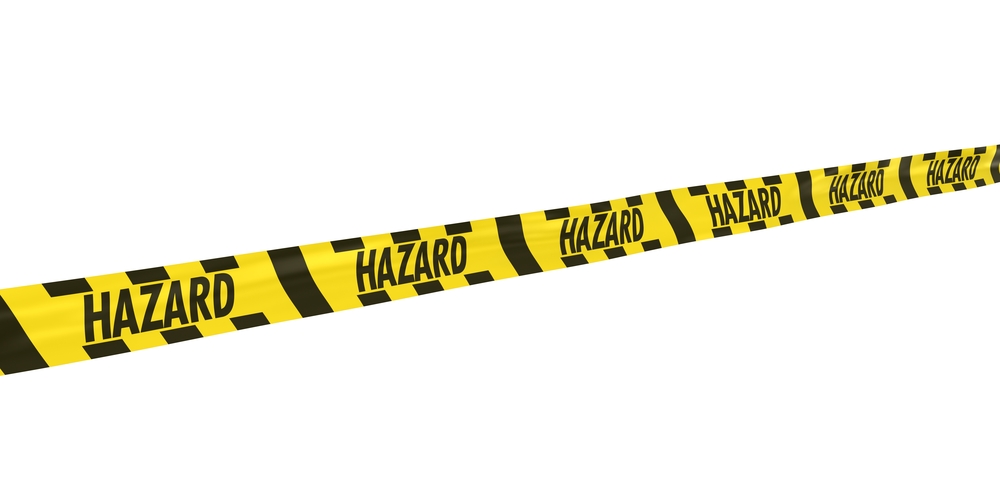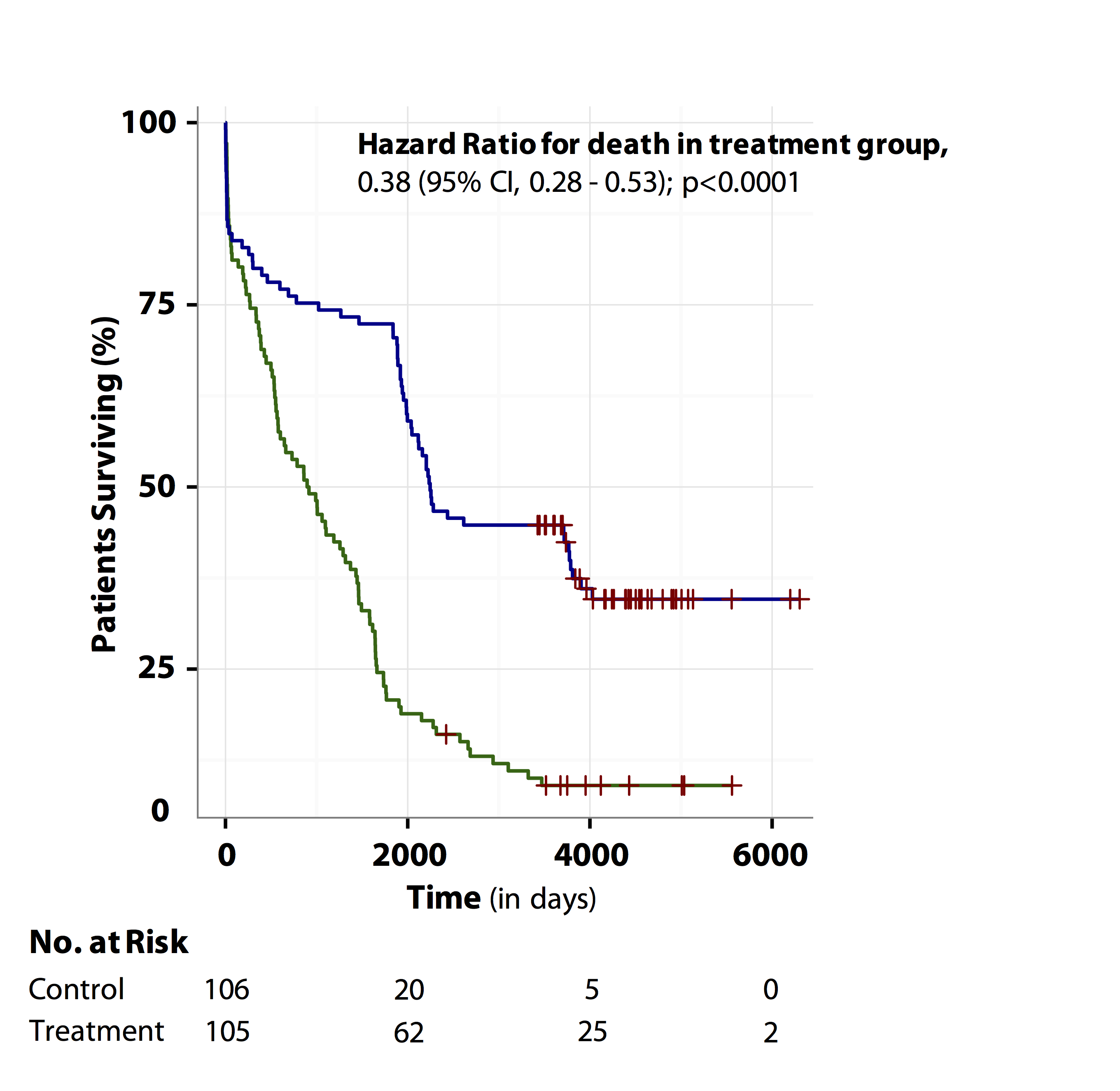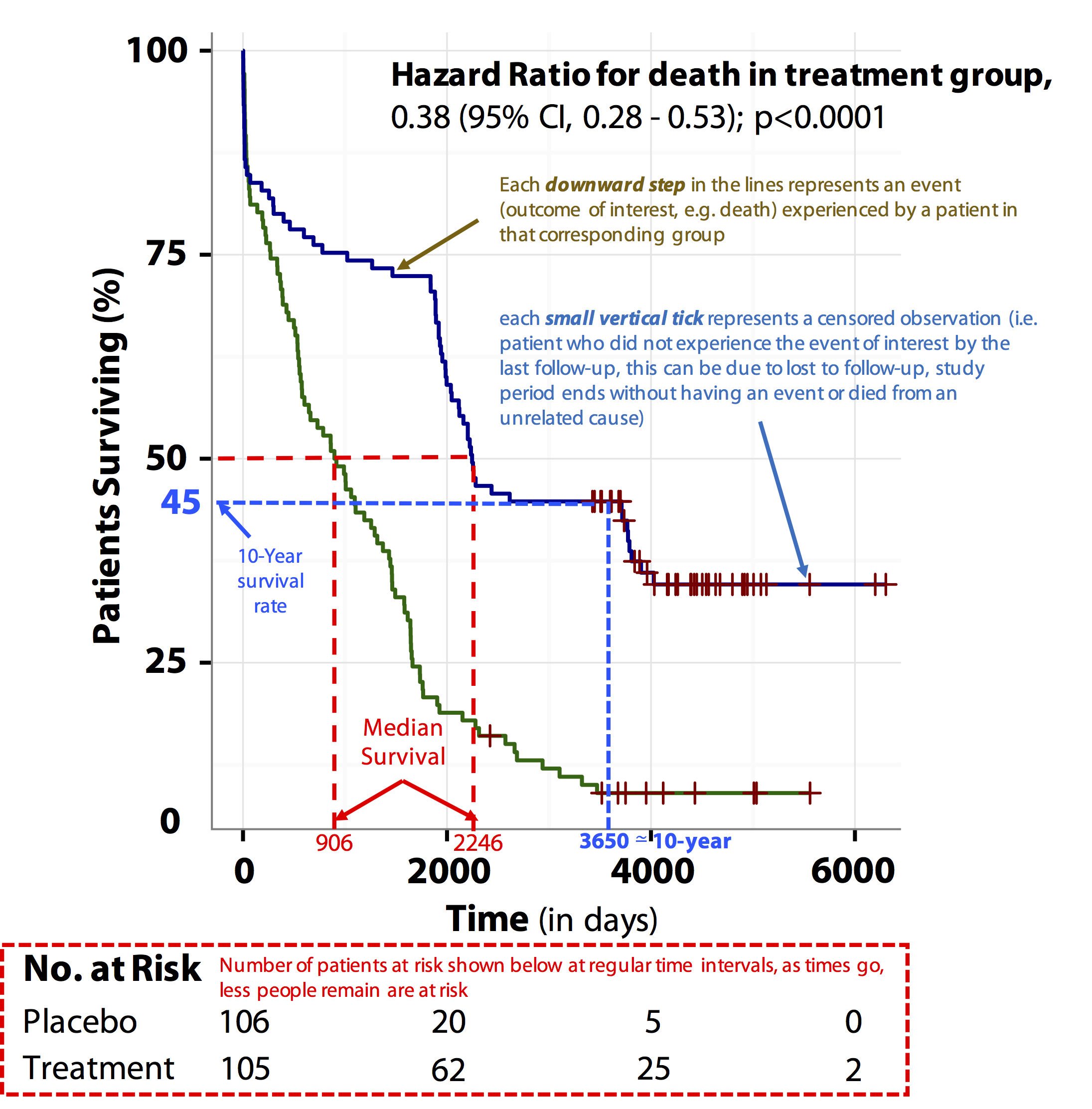Tutorial about Hazard Ratios
Posted on 5th April 2016 by Loai Albarqouni

You have been asked to run a journal club in your department about heart failure. You followed the key steps of Evidence-Based Practice that you have learned: formulated a clear searchable clinical question, searched the main databases and came across this recent hypothetical article.
In this hypothetical article, the authors conducted a randomised controlled trial to investigate the effectiveness of a new treatment for improving the survival of patients with heart failure. A total of 105 patients were randomised to the treatment group and a total of 106 were randomised to the control group. The primary outcome was the overall survival rate.
The main result of this trial can be summarised in this paragraph: “After a median follow-up of 1500 days, the hazard ratio for death in the treatment group, 0.38; 95% confidence interval [CI], 0.28 to 0.53; P<0.0001).”
In addition, the authors presented the figure below summarizing their main results:
Figure produced by the author using R software
(Blue line represents treatment group and green line represents control group).
You want to critically appraise the article. However, you have some difficulty understanding its main results and have a few questions:
- What is Hazard Ratio? What do the authors mean by 95% confidence interval? How can you interpret this information?
- How can I read the figure? What are the main findings I can learn from this figure?
- How can I convey this information to my patients?
In this blog, you may find the answers to these questions.
What is a Hazard Ratio & what are Confidence Intervals?
Hazard ratio (HR) is a measure of an effect of an intervention on an outcome of interest over time. Hazard ratio is reported most commonly in time-to-event analysis or survival analysis (i.e. when we are interested in knowing how long it takes for a particular event/outcome to occur).
The outcome could be an adverse/negative outcome (e.g. time from treatment/surgery until death/relapse) or a positive outcome (e.g. time to cure/discharge/conceive/heal or disease-free survival).
Hazard Ratio (i.e. the ratio of hazards) = Hazard in the intervention group ÷ Hazard in the control group
Hazard represents the instantaneous event rate, which means the probability that an individual would experience an event (e.g. death/relapse) at a particular given point in time after the intervention, assuming that this individual has survived to that particular point of time without experiencing any event.
Confidence Interval (CI): is the range of values that is likely to include the true population value and is used to measure the precision of the study’s estimate (in this case, the precision of the Hazard Ratio). The narrower the confidence interval, the more precise the estimate. (Precision will be affected by the study’s sample size). If the confidence interval includes 1, then the hazard ratio is not significant.
Interpretation of Hazard Ratio
Because Hazard Ratio is a ratio, then when:
HR = 0.5: at any particular time, half as many patients in the treatment group are experiencing an event compared to the control group.
HR = 1: at any particular time, event rates are the same in both groups,
HR = 2: at any particular time, twice as many patients in the treatment group are experiencing an event compared to the control group.
Applying this to our hypothetical study results:
In the results, the authors reported that the hazard ratio for death with the new treatment = 0.38 (95% CI, 0.28-0.53; P<0.0001). What does that mean?
Patients in the new treatment group at any time point during the study period were 62% less likely to die than patients in the control group, and we are 95% confident that the true value is lying between 47%-72%. (i.e. we are 95% sure that patients in the new treatment group were between 47% and 72% less likely to die than patients in the control group).
Kaplan-Meier curve (or Survival curve)
Figure produced by the author using R software
(Blue line represents treatment group and green line represents control group).
Kaplan-Meier curve: is a graphical method of displaying survival data or time-to-event analysis (i.e. the proportion of patents surviving against time) and is usually drawn as a step function.
- The horizontal axis represents the time of follow-up starting from enrolment while the vertical axis represents the estimated probability of survival.
- Each downward step in the lines represents an event (the outcome of interest, e.g. death) experienced by a patient in that corresponding group, while each small vertical tick represents a censored observation (i.e. a patient who did not experience the event of interest by the last follow-up. This can be due to being lost to follow-up, the study period ending without an event or because the patient died from an unrelated cause).
- The numbers of patients at risk at regular time intervals is shown at the bottom of the figure. With time, fewer people remaining are at risk.
- This graph also allows you to detect the progression of the condition (e.g. early postoperative mortality or a serious adverse event caused by the drug), by the presence of a notable sudden steep drop in survival at a particular time point.
Interpretation of this figure
The results of this graph can be communicated in various ways:
- Median survival: half of the patients in the treatment group have survived for 2246 days (median survival rate) compared to 906 days in the control group.
- Difference in median survival: On average, patients in the intervention group survived for 1340 days longer than patients in the control group (2246 – 906 days).
- Proportion surviving at a specific time point: about 45% of patients in the treatment group have survived for 10 years (3650 days, i.e. 10-year survival rate). Another way of saying this is that about 45% of the patients in the treatment group have not experienced the outcome of interest (e.g. death) after 10 years of follow-up.
Hazard Ratios vs. Risk Ratios (or Relative Risk)
Hazard ratio is frequently interpreted as risk ratio (or relative risk), but they are not technically the same. However, if that helps you to understand hazard ratio then it is OK. But keep in mind HR is not RR.
One of the main differences between risk ratio and hazard ratio is that risk ratio does not care about the timing of the event but only about the occurrence of the event by the end of the study (i.e. whether they occurred or not: the total number of events by the end of the study period). In contrast, hazard ratio takes account not only of the total number of events, but also of the timing of each event.
References & Further Reading
- Altman D.G., Bland J.M. Time to event (survival) data. BMJ 1998; 317:468
- Bland J.M., Altman D.G. Survival probabilities (the Kaplan-Meier method). BMJ 1998;317:1572
- Spruance S.L., Reid J.E., Grace M., Samore M. Hazard ratio in clinical trials. Antimicrob Agents Chemother 2004; 48: 2787–2792.
- Sedgwick P. How to read a Kaplan-Meier survival plot. BMJ 2014; 349: g5608
- Sedgwick P. Hazards and hazard ratios. BMJ 2012; 345: e5980






No Comments on Tutorial about Hazard Ratios
Your tutor is very precise and exellent one. It is clear and easily understandable. I always follow your tutor.
16th January 2020 at 2:19 pmI impressed by this one and I wanted the pdf of this tutor. Would you send me via my email(girmapharm@gmail.com) if it is possible?
I also want to know how the following be interpreted in survival time to death:-
Baseline weightof the patient, HR= 1.03 and age of the patient HR=0.98
assume the weight and age of the patient are continuous.
Please respond soon as possible.
Thank you in advance.
wonderful way to explain ….. worth reading the blog.
15th October 2019 at 5:24 amdefinitely good for medical students and also for teachers.
Great !!! I finally got it!! Thank you and hello from Brazil
18th September 2019 at 2:31 amHi Laoi,
Great job on explanation. Could you help me understand:
Drug A vs placebo: Stable disease in 66.7% vs 37.2% at 12 months p=0.00007 HR 0.34 (95% CI, 0.20-0.59)
How do you verbalize this data?
23rd July 2019 at 6:28 pmA comment from Twitter from Ralph Brinks (Mathematician): Thx for sharing 👍 Not 100% accurate in 2nd part of the def “Hazard [rate] represents the instantaneous event rate, which means the probability that an individual would experience an event”. It’s not a probability (bc can be > 1) but a limit. See Kalbfleisch & Prentice – “The Statistical Analysis of Failure Time Data”.
22nd July 2019 at 10:58 amwhat about median endpoint ratio
1st April 2019 at 8:11 amthank you, great tutorial
4th February 2019 at 9:13 pmGreat topic
26th January 2019 at 8:53 pmIn case anyone is looking for a quick and easy way to calculate a hazard ratio, HR p-value and confidence intervals, I found this free tool: https://www.gigacalculator.com/calculators/hazard-ratio-calculator.php . Real easy to use as well, just copy & paste from a spreadsheet.
17th January 2019 at 11:04 amGood stuff.Thank you Loai
19th November 2018 at 9:44 pmThank you, thank you, thank you for explaining these complex stats so well.
17th October 2018 at 3:55 amMay I commend the clarity in which you have presented Hazard Ratio.
21st September 2018 at 11:56 pmNice explanation
18th September 2018 at 5:25 amvery informative for M.D.’s thanks
5th September 2018 at 4:29 amThank you !
6th August 2018 at 2:33 pmWhat does a hazard ratio of 1.75 mean?
9th July 2018 at 1:29 pmci IS .25 TO .53 tHEN WHERE IS THE 47 TO 72% COME FROM?
17th May 2018 at 5:02 pmhi there
6th March 2018 at 8:36 amcould you please tell me how to calculate CI from HR & P value in an published article?
it should be noted that i havnt any data about participants in this study.
i need it for my meta analysis article
regards
Thank you so much for the explanation, so easy to understand, gonna share it with the whole team. Bless you!
15th November 2017 at 7:48 amHazard ratios are by definition time-dependent and thus must change as a function of time, except in the exponential case. How then can there be a single, summary hazard ratio for two different (non exponential) survival curves? Is there an agreed upon comparison time, say the median for each?
10th November 2017 at 11:47 pm